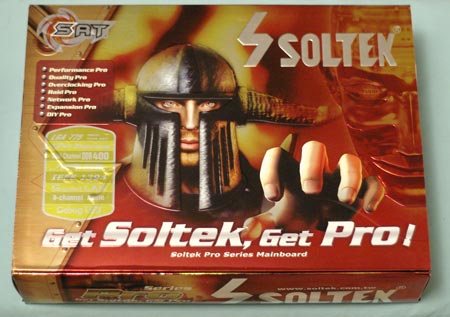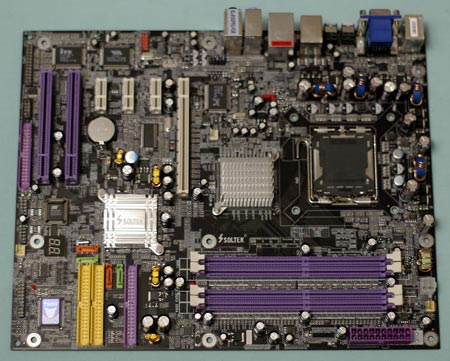915 Motherboard Roundup: Socket 775 for the Rest of Us
by Wesley Fink on December 7, 2004 12:25 AM EST- Posted in
- Motherboards
Soltek SL-915GPro-FGR: Features and Layout
| Soltek 915GPro-FGR Motherboard Specifications | |
| CPU Interface | Socket 775 Pentium 4 (Prescott) |
| Chipset | Intel 915P/ICH6 |
| BUS Speeds | 200MHz to 350MHz (in 1MHz increments) |
| DDR2 Speeds | Auto, 333, 400 |
| CPU Voltage | Auto, 0.85V to 1.60V in 0.0125V increments |
| DRAM Voltage | 2.6V to 2.9V in 0.1V increments |
| vCore (Chipset) Voltage | 1.50V-1.80V in 0.1V increments |
| Memory Slots | Four 184-pin DDR400 Slots Dual-Channel Unbuffered Memory to 4GB |
| Expansion Slots | 1 PCIe x16 Slot 3 PCIe x1 slot 2 PCI Slots |
| Onboard SATA/IDE RAID | 4 SATA 150 drives by ICH6 |
| Onboard IDE/RAID | One Standard ATA100/66 (2 drives) Plus 4 drives by ITE IT 8212F ITE drives RAID 0, 1, 0+1 |
| Onboard USB 2.0/IEEE-1394 | 8 USB 2.0 ports 2 IEEE 1394a FireWire Ports by VIA VT6307 |
| Onboard LAN | Gigabit PCI Ethernet by Realtek 8110S |
| Onboard Audio | AC'97 2.3 Realtek ALC850 8-Channel with SPDIF in/out |
| Tested BIOS | 1.3 AMI |
The Soltek 915GPro-FGR is the only motherboard in the roundup that is based on the Intel 915G chipset. Soltek has marketed the 915Gpro-FGR in the Pro packaging, which is reserved for the top Soltek boards.

The 915GPro-FGR is a PRO board targeted to provide outstanding value in the 915 market in a full-size board with integrated graphics. Unlike many of the OEM micro-ATX 915G motherboards, the Soltek is targeted to be satisfying for both the integrated graphics shopper and the enthusiast looking for a 915P motherboard. Does the Soltek succeed in satisfying both markets?
From a features standard, the Soltek is a bit too stripped for our tastes. We found this Soltek selling for about $126 at www.newegg.com, which is a low to mid-range price for a full-featured 915P board. However, Soltek has built the 915G Pro with the ICH6 south bridge instead of the ICH6R, so users will have to forego the advantage of Intel Matrix Raid. Many other boards designed to sell in this price range also do without the R south bridge, so this compromise makes sense. However, Soltek also does away with Intel High-Definition audio, opting instead for the 8-channel AC'97 2.3 ALC850. The Realtek 850 is a capable codec, but it does not boast specs that really compete with Azalia HD audio. Soltek does provide Gigabit LAN on the 915GPro, but the LAN runs on the slower PCI bus instead of the faster PCI Express bus. This will matter a great deal to some users and not at all to others. Also included are two Firewire ports, though they are the slower 1394a versions rather than the high-speed 1394b versions. A significant addition is the ITE 8212 controller, which adds four IDE ports to the anemic 2 IDE ports on the Intel ICH6. The IDE drives can also be combined in RAID configurations if the user chooses. Soltek does manage to provide a very complete lists of 915 features, including Intel integrated graphics, on a full-featured board that sells for just $126. We wish, however, that Soltek had at least found some way to keep high-definition audio on the feature list. If ICH6R, a PCIe Gigabit LAN instead on Azalia HD, had added about $15 to the total, we think that most buyers would prefer it; though, we do understand building to a price point.
The BIOS ranges and adjustments would be right at home on any quality 915P board. Memory voltage adjustments, CPU voltage, and chipset voltage all feature useful ranges that are at least as good as most others on 915 boards in this roundup. The same can be said for the range of FSB adjustments, since the 200-350 range will cover any FSB that you can actually use on a 915 board - even at 14X ratio.

The Soltek is well laid out. In fact, we were more than a little surprised to find Soltek using the much preferred board edge locations for both the 20/24-pin power connector and the 4-pin 12V. These work best in most systems. The IDE and floppy connectors are located at the board edge, but on the lower right edge of the board instead of the preferred upper right. Even though they are not in the most preferred location, they still work well in most case designs.
Also located at the lower right are the 2-digit diagnostic LEDs and the 4 SATA connectors. While this is a busy area, you should have no problem with connectors here. Feature headers are located along the bottom edge of the board, which also contains the board's glaring misplacement - another floppy connector at the bottom of the board. This location for the floppy is particularly bad for tower cases, as you will need to find an extra long floppy cable to make a connection. This is particularly true in tower cases where the floppy drive is located in a top bay. Since many users no longer use a floppy drive, the floppy location won't matter at all.
MSI 915P Neo2 Platinum: Overclocking and Stress Testing
Soltek SL-915GPro-FGR: Overclocking and Stress Testing










26 Comments
View All Comments
Live - Tuesday, December 7, 2004 - link
Sorry Didn't see your reply before I posted Wesley.Sure there is some value to be had but not "outstanding". I still don't agree with you but I guess my mind is made up. Intel needs to come out with something new before I go back.
As a roundup it was very good reading tough. I can't wait for the next AMD roundup to hit AnandTech.
Live - Tuesday, December 7, 2004 - link
#12"The P5GD2 is an expensive motherboard, at about $240 on the web, but you can get almost all the same features in the P5GD2 Deluxe for about $50 less."
Thats expensive to me. Compare that to the 134.99 for the 939 Gold Editors Choice winner "MSI K8N Neo2 Platinum"
But thats not the point. If the 915P was substantially cheaper then a 939 system you might call it value for money but is it not. Mind you a 939 board is generally not cheap either but at least it delivers in comparison.
The CPU used in the review that hardly beat the much cheaper 3500+ had a max overclock of 14% and I bet you would find it hard to reach that high without the CPU overheating and start throttling http://www.anandtech.com/news/shownews.aspx?i=2345...
LGA775 CPUs does not offer great overclocking headroom compared to the much cheaper earlier Intel platforms or AMD for that matter. Sure they still overclock but nothing that we haven't seen before at higher cost and temperature. Again not what I would call outstanding.
Wesley Fink - Tuesday, December 7, 2004 - link
#11 - We just ran the 3500+ benchmarks in the same configuration this morning, and we do agree that the 3500+ is a particularly good value in performance for the dollar. However, the larger picture of prices of AMD CPUs compared to Intel show the Intel processors are a good, if not outstanding, value.Our conclusion was based on Anand's value analysis in the 3.46EE/1066 launch review at http://www.anandtech.com/cpuchipsets/showdoc.aspx?... There he compared the 3800+ at over $600 to a Intel 560 3.6GHz at about $450 and found the 3800+ the winner but probably not a big enough winner to justify the price premium for the 3800+. At that time, there was no 570 (3.8GHz) and the 3.6 was the fastest Intel CPU unless you considered the $1000+ Xeon-based EE processors. Price changes continue, and with them the value relationships do change.
A quick check of prices today shows
Intel 520(2.8GHz)- $160 AMD 2800+(754) - $128
Intel 530(3.0GHz)- $180 AMD A64 3000+ - $152
Intel 540(3.2GHz)- $220 AMD A64 3200+ - $194
Intel 550(3.4GHz)- $282 AMD A64 3400+ - $269
Intel 560(3.6GHz)- $455 AMD A64 3500+ - $270
Intel 570(3.8GHz)- $795 AMD A64 3800+ - $630
AMD A64 4000+ - $716
AMD A64 FX55 - $812
With current prices we would have to agree that there is really no great value advantage to Intel any more. But there is good value in the Intel processors from 2.8GHz (520) to 3.6GHz (560). Certainly the 4000+, at $80 less than the 570 and faster performance, and the FX55 at about the same price as 570 and significantly faster in most benchmarks, are better value at the top. But we still stand by Intel being good value in the middle.
deathwalker - Tuesday, December 7, 2004 - link
"outstanding value and performance for your buying dollar" ?????????? at $240 for a Mobo?..I guess I need to retake Economics 101...Bah...Intel just continues to shot themselves in the foot. A side note not related to this review..Dell must be deep inside of Intel's pocketbook with there contiued refusal to market AMD based products.danidentity - Tuesday, December 7, 2004 - link
#11 - 915P motherboards are not expensive. They are equal or cheaper in price than socket 939 A64 motherboards.LGA775 CPUs offer great overclocking headroom if paired with the right board. Intel CPUs have traditionally have had more OCing headroom than AMD chips. That still holds true, for the most part, today. Especially when talking about the low-end chips, like the 2.8GHz.
Live - Tuesday, December 7, 2004 - link
I'm sorry but I don't see the "outstanding value and performance for your buying dollar"Expensive Motherboards and CPUs with little overclocking headroom compared to the Athlon 64 competition. How does that translate to excellent value and performance? even the much cheaper 3500 comes out on top on most benchmarks.
Sure there are niche markets where the Intel platform excels but for the big majority of us AMD is where its at right now.
I don't think this review is in sync with your conclusion so either list some valid arguments for your point (Since its not there in the benchmarks) or edit the conclusion.
danidentity - Tuesday, December 7, 2004 - link
Wesley, thanks for including tests from a more comparable AMD CPU. Listening to your readers is always appreciated.Wesley Fink - Tuesday, December 7, 2004 - link
#4,#5,#6 - The Athlon 64 results with the FX55 were included for Reference, and not direct comparison. However you do make a good point.The closest A64 we had in the lab to a 3.6GHz 560 was the 3500+ based on the 90nm process. This should provide an advantage to the Intel 560. Since there are complaints here the FX55 is too high end, these new tests tilted toward Intel should balance the playing field. The 3500+ costs about $265 and the Intel 560 (3.6GHz) is about $455, so the 560 is about 70% more expensive than the 3500+.
The added 3500+ benchmarks were also an opportunity to test with the SAME ATI X800XT PCIe we used in benchmarking the 915 boards. Enjoy!
Color codes have been updated and there are now 3500+ results on the Gigabyte nForce4 with the ATI X800XT PCIe in all benchmarks.
Original plans were to include the Intel 570 in this roundup, but much of the testing was already done when the Intel 3.8GHz CPU was launched. This Intel 3.8 is priced at around $800, which is very close to the FX55. You can see how it compares to the FX55 in performance in Anand's launch article at http://www.anandtech.com/cpuchipsets/showdoc.aspx?...
CrystalBay - Tuesday, December 7, 2004 - link
It's a pity that all these 4 dimm slot, dual channelMB's have such a rough time doing it. Imagine trying
to run 4 1GB dimms in DC, this goes for ddr1 as well 2.
Glassmaster - Tuesday, December 7, 2004 - link
Now that Northwood and 865/875 are on the way out, only a fool would buy Intel.Glassmaster.